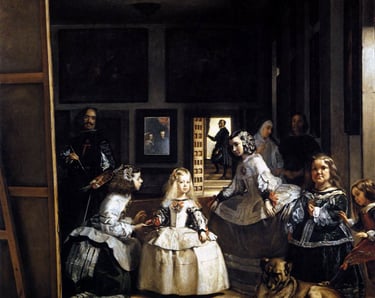A small chat extending from two figures by Velazquez
Cen Long
6/30/2016
By Diego Rodríguez de Silva y Velázquez


Whenever the quiet night grasps me, some figures appear to accompany my thoughts, they may be family, or companions. Sometimes, however, there appear faces of whom I never knew, figures from the paintings of the great. Two of those figures, quite magically, belong four decades before me. But nevertheless, their faces appear so familiar and almost palpable. I fancied to have heard the soft sound of their breath, and felt the smell of garlic and onion coming off of them. It is the jester Don Juan Calabazas and the prophet Aesop in the paintings of “The Dwarf Don Juan Calabazas.”
Calabazas has a very ordinary face, his anxious hands are tightly held together out, and appears to be listening attentively with a bashful and humble smile. He has some deformity in his eyes, and amblyopia is the reason to his severe sideway glances… Many physical deformities seem to be burdened upon this unfortunate jester. Velazquez, however, bestowed on this figure, the most precious quality of humanity-kindness; this jester has the most benign and innocent smile. This smile signifies Calabazas’ impotence towards his innate malformation and the subsequent ill-fate. To earn enough to sustain himself, he has to please the royalties whenever they need him to showcase his inane look and tricks. Meanwhile, to others, he is incapable to pose any threat whatsoever. One can sense the artist’s deep sympathy and pity, not an insinuation of disdain, towards Calabazas. This kind of emotion is quite peculiar compared to some of Velazquez’ other works. For example, the frosty and haughty demeanor of the little princess in “The Royal Family, 1656” contrasts sharply the simple and plain grin of Calabazas. In choosing the style to depict both figures, Velazquez made a great difference between the two paintings.


When portraying Calabazas, Velazquez uses refined and delicate touches, and the intermediary between strokes are subtle and detailed. It is rather obvious that he has used his palm to brush gently through Calabazas’ forehead and chin, etc. to make the transitory between the light and dark, and different structures more natural and consonant, and also as a mean to attenuate the tranquil atmosphere of the painting. The darker parts that are colored with a warm green renders the background in harmony with the rest. The bolder and more buoyant strokes are mostly used on Calabazas’ hands, and sums up effectively the jester’s uneasiness in his gesture and mood out of nervousness. There is an awkward smirk on Calabazas’ face, and it seems to be his way of dealing with the painter’s casual small talks aimed to lessen the tension, but he is really timid and self-conscious. On the occasion of painting the little princess, Velazquez draws with a direct painting method that uses wet strokes: He dabs the area with light colors where the darker colors are still wet to create the appearance of illumination, and at the same time, achieved a transition between the intersection of the bright and dark. The condescension, arrogance and pride in the little princess’ attitude is apparent as she is centered by her handmaidens and a female dwarf. Comparing the two paintings, I have a very strong preference towards Calabazas’ portrait, because it is approachable and amicable, and has a sense of déjà vu. It reminds me of an adept street artist I met once, and an old friend dwelling in the countryside who enjoys telling humorous jokes.
By Diego Rodríguez de Silva y Velázquez
By Diego Rodríguez de Silva y Velázquez
As for Aesop, another character created by Velazquez, is another embodiment of my feelings. Velazquez depicts a typical philosopher who is born into slavery but bear more than anything an eminent intelligence and wisdom. He is fairly ugly, but not as grotesque as told in the legends. His face is wan and withered, and is a little swollen, but he stands against the vast population of vulgarity and mediocrity with his defiant small eyes. His slim lips are closed firmly, with a definite confidence, revealing to the viewers that any words that slip his mouth will undoubtedly be enlightening verses. The philosopher Aesop, calls to my mind my father and a few elderly scholars who stood out apparently when compared to other. They were aloof and dignified, and regardless of the perilous reality, spoke nothing but the truth. They were the defenders for the dignity of the academia, and were the apologists and martyrs for the absolute truth. Small and fragile may their bodies be, but they have great and noble souls.
Velazquez is truly brilliant, he insisted on a path unknown to anyone beforehand, he opposed the rigid style adopted by steadfast practice of mimicking the ethereal and solemn religious realm. He persisted in depicting the real word, truthfully reflecting humanity and civilization as he saw. His paintings have the intensity of real life and flesh. And the most extraordinary is that in his works there is a voice, a soul and the tracings of his consciousness. Albeit Velazquez said that “I only draw what I see”, planted in his works were his realization of humanity, notably, his awareness of psychological and mental processes of humans. This awareness in his works is why the characters in his paintings are alive, even if time has eroded many other things. Hundred years has past unnoticed, but when we encounter one figure of Velazquez’s creation, the familiarity hints a re-encounter after a recent breakup.
Today, when evaluating the value of an artwork, the quality that demands the upmost attention is whether or not there is a lively soul. And this spirit, regardless of the passing of time, will continue to shake and swoon the hearts of the viewers, which is what truly matters. I find, that rather than the noble men and women Velazquez paints, it is his mundane characters that attracts me. Maybe, it is because of Velazquez’ upbringing as a commoner, that he understands the ordinary more thoroughly than the class of privileged people, which makes the connotations and tension of their portrait more moving and extraordinary.





